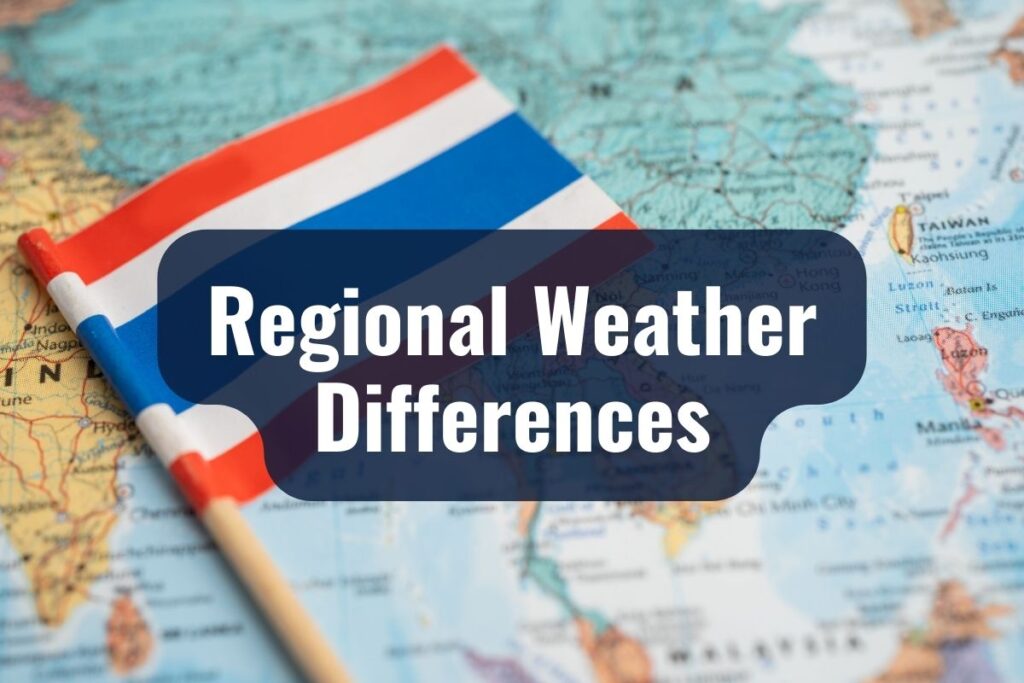Due to its geographical location, Thailand enjoys a tropical climate, characterized by high temperatures and humidity throughout the year. January, in particular, offers a mix of mild temperatures and reduced rainfall, making it an appealing month for visitors.
This article delves into the specifics of Thailand’s weather in January, equipping you with the insights you need for a comfortable and enjoyable stay.
KEY TAKEAWAYS
- November marks Thailand’s transition from the rainy to cool season, offering diverse weather patterns.
- Regional variations in November can influence travel experiences across different parts of Thailand.
- Clothing choices in November should balance comfort with regional climate variations and cultural norms.
- Loy Krathong is a significant cultural event in November, alongside various other regional festivals.
- Traveling in Thailand during November combines the beauty of lush landscapes with rich cultural immersion.
- Prioritizing health and safety ensures a fulfilling travel experience, from weather precautions to understanding local customs.
Temperature Overview
January is one of the cooler months in Thailand, providing a welcome respite from the intense heat experienced during other times of the year. However, the term “cooler” is relative and varies across the country’s diverse regions. Let’s explore the average temperatures one might encounter in January.
Northern Thailand
In regions like Chiang Mai and Chiang Rai, you can expect temperatures to range from a comfortable 14°C (57°F) during early mornings and nights to about 29°C (84°F) during midday.
Central Thailand
The central plains, where cities like Bangkok and Ayutthaya are located, see slightly higher temperatures. Morning lows tend to hover around 20°C (68°F), while daytime highs can reach 32°C (90°F). The urban heat island effect, especially in Bangkok, might make the city feel warmer than surrounding areas.
Southern Thailand
The southern region, being closer to the equator, remains relatively warm.
East Coast (Koh Samui, Phangan): Temperatures typically stay between 24°C (75°F) and 31°C (88°F).
West Coast (Phuket, Krabi): You’ll find a similar temperature range, though it can occasionally be slightly cooler in the evenings.
Precipitation and Humidity

When discussing weather, understanding the levels of precipitation and humidity is vital, especially in a tropical country like Thailand. January, being in the midst of the dry season, presents certain characteristics in terms of rainfall and moisture in the air.
Northern Thailand
The northern regions, including Chiang Mai and Chiang Rai, experience minimal rainfall in January. It’s one of the driest months of the year, with occasional light showers, if any. Humidity levels are relatively low, averaging around 50-70%.
Central Thailand
Cities like Bangkok and Ayutthaya in the central region also enjoy a dry spell during January. Rainfall is sparse and usually short-lived when it does occur. The humidity, influenced by the proximity to the Gulf of Thailand, averages between 60-75%.
Southern Thailand
The south of Thailand exhibits a slightly different pattern due to its dual coastlines:
East Coast (Koh Samui, Phangan): January is relatively dry, with occasional brief showers. The humidity remains moderate, hovering between 65-80%.
West Coast (Phuket, Krabi): This side tends to receive a bit more rainfall than its eastern counterpart, though it’s still less than the monsoon months. Expect humidity levels to be in the 70-85% range.
Regional Weather Differences

Thailand’s diverse landscape, from mountainous terrains in the north to sandy beaches in the south, contributes to varied weather patterns across its regions. In January, these differences become particularly noticeable.
| Region | Temperature & Conditions |
| Northern Thailand | Cool mornings and evenings, occasional mist or fog |
| Central Thailand | Warmer temperatures, clear skies, urban heat in Bangkok |
| Southern-East Coast | Mix of sunny days with brief showers, calm seas |
| Southern-West Coast | Potential for more rainfall, brief afternoon showers |
North (Chiang Mai, Chiang Rai)
The northern provinces, enriched with mountains and valleys, experience cooler temperatures compared to the rest of the country. Early mornings and late evenings can be surprisingly cool, especially in higher altitudes. This region also occasionally witnesses mist or fog, adding a mystical charm to its already scenic beauty.
Central (Bangkok, Ayutthaya)
The central plains, dominated by Bangkok and historic cities like Ayutthaya, exhibit warmer temperatures. The vast urban expanse of Bangkok often results in the urban heat island effect, making it feel a tad warmer than its neighboring areas. Rainfall is generally scarce, and clear skies are the norm, perfect for sightseeing and outdoor activities.
South-East Coast (Koh Samui, Phangan)
The eastern coast of southern Thailand, housing popular islands like Koh Samui and Phangan, sees a mix of sunny days with brief showers. The sea remains relatively calm, making it ideal for beach activities and water sports.
South-West Coast (Phuket, Krabi)
In contrast, the west coast, with destinations like Phuket and Krabi, can experience slightly more rainfall. However, these showers are usually short-lived and often occur in the late afternoon or evening. The Andaman Sea can be a bit more turbulent, so those planning marine activities should stay informed about local weather conditions.
Clothing Recommendations

One of the primary concerns for travelers venturing into a new country is ensuring they pack the right clothing to suit the weather conditions. With Thailand’s regional weather differences in January, it becomes essential to tailor your wardrobe accordingly.
Northern Regions (Chiang Mai, Chiang Rai)
Early mornings and evenings: Consider packing a light sweater or a jacket. Layers are your friend here, as you can remove them when the day warms up.
Daytime: Lightweight clothing like T-shirts and jeans or trousers. Comfortable walking shoes are a must if you plan to explore the city or the countryside.
Central Regions (Bangkok, Ayutthaya)
Urban Exploration: Breathable fabrics are crucial due to the higher temperatures. Consider short-sleeved shirts, shorts, or light trousers.
Temples and Historical Sites: It’s important to note that most temples require modest clothing. This means covering your shoulders and wearing pants or skirts that go below the knee. Always carry a scarf or a wrap, which can be handy in such situations.
Southern Regions (Both East and West Coasts)
Beach destinations: Swimsuits, beachwear, and flip-flops are essentials. However, pack a pair of sandals or closed shoes for inland exploration.
Evening outings: While it remains warm, some might prefer a light shawl or long-sleeved top for nighttime activities or dining by the beach.
Across all regions, it’s crucial to remember:
Sun Protection: A wide-brimmed hat, sunglasses, and sunscreen are essential, even in the cooler months.
Rain Gear: Though January is drier, a compact umbrella or a light rain jacket can be handy, especially in the southern regions.
Activities and Planning
January’s pleasant weather in Thailand paves the way for a range of activities. Let’s delve into ideal ventures and provide tips for ensuring your plans align with the month’s climatic nuances.
Northern Thailand (Chiang Mai, Chiang Rai)
Outdoor Exploration: This is a prime time to hike the mountainous terrains or explore the serene countryside. The cool temperatures make for comfortable treks.
Temple Visits: Explore the historical temples without the discomfort of excessive heat. The clear skies ensure breathtaking views, especially from hilltop temples.
Central Thailand (Bangkok, Ayutthaya)
City Tours: January’s clear skies make rooftop dining in Bangkok or river cruises especially enchanting.
Historical Exploration: Visit the ruins in Ayutthaya or the Grand Palace in Bangkok. The mild weather ensures you can spend more time outdoors without feeling too drained.
Southern Thailand
East Coast (Koh Samui, Phangan)
Beach Activities: Sunbathing, swimming, and other beach activities are popular, thanks to the generally calm seas.
Water Sports: Diving and snorkeling conditions are favorable, with clearer waters enhancing visibility.
West Coast (Phuket, Krabi)
Island Hopping: Explore the numerous islands, but always check the day’s weather forecast as brief showers can sometimes occur.
Local Festivities: January often sees local festivals, like the Phuket Old Town Festival, offering travelers a taste of the region’s rich culture.
General Tips for Planning Activities in January
Stay Informed: Always check local weather forecasts, especially if you’re planning marine activities in the south.
Book in Advance: January is a popular month for tourism in Thailand. Booking activities or excursions in advance can ensure availability.
Stay Hydrated: Regardless of the cooler temperatures, the sun can be strong. Regularly drink water, especially if you’re engaging in physical activities.
Precautions and Health Tips

While January’s weather in Thailand is largely favorable, it’s paramount to consider some precautions and health tips to ensure a safe and enjoyable stay.
Sun Protection
Sunscreen: Even on cloudy days, the UV index can be high. Regularly apply a broad-spectrum sunscreen with an SPF of 30 or higher.
Limit Exposure: Between 10 am to 4 pm, the sun is at its strongest. If possible, seek shade or plan indoor activities during these hours.
Hydration
Drink Water: Regularly consume water to stay hydrated, especially if indulging in outdoor activities.
Avoid Dehydration: Limit alcohol and caffeinated beverages, as they can dehydrate the body.
Food and Beverages
Safe Consumption: Stick to bottled water and ensure any ice in drinks comes from a clean source.
Street Food: While Thai street food is a must-try, opt for stalls that are popular and appear clean.
Insects
Protection: In some regions, there’s a risk of mosquito-borne diseases. Use insect repellent and wear long-sleeved clothing during dusk and dawn when mosquitoes are most active.
Changing Weather
Stay Updated: Even though January is generally dry, sudden weather changes can occur, especially in the southern regions. Keep a weather app handy and adjust plans accordingly.
Personal Health
Medication: If you’re on regular medication, ensure you have an adequate supply. Also, keep a list of any allergies or health conditions handy in case of emergencies.
Local Clinics: Familiarize yourself with the location of nearby clinics or hospitals, especially if traveling to remote areas.
Thailand, with its captivating blend of culture, nature, and hospitality, is a destination that promises unique experiences year-round. January, with its mild temperatures and decreased rainfall, showcases the country in a particularly pleasant light.
By understanding the regional weather nuances and taking the necessary precautions, visitors can fully immerse themselves in the myriad of activities and sights the “Land of Smiles” has to offer. Whether it’s the misty mountains of the north, the bustling cityscapes of the central region, or the sun-kissed beaches of the south, Thailand in January awaits with open arms and clear skies. Safe travels and enjoy your Thai adventure.
Looking for more weather info?


